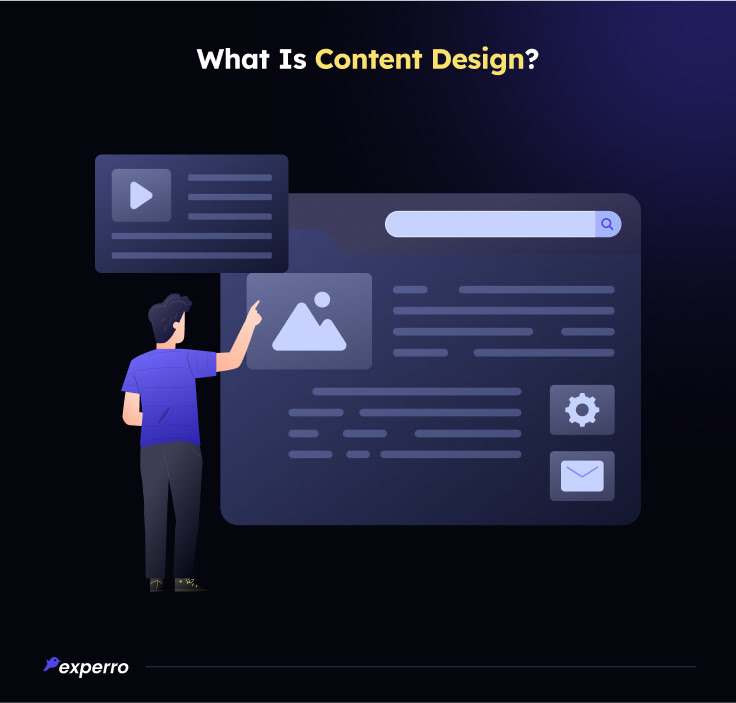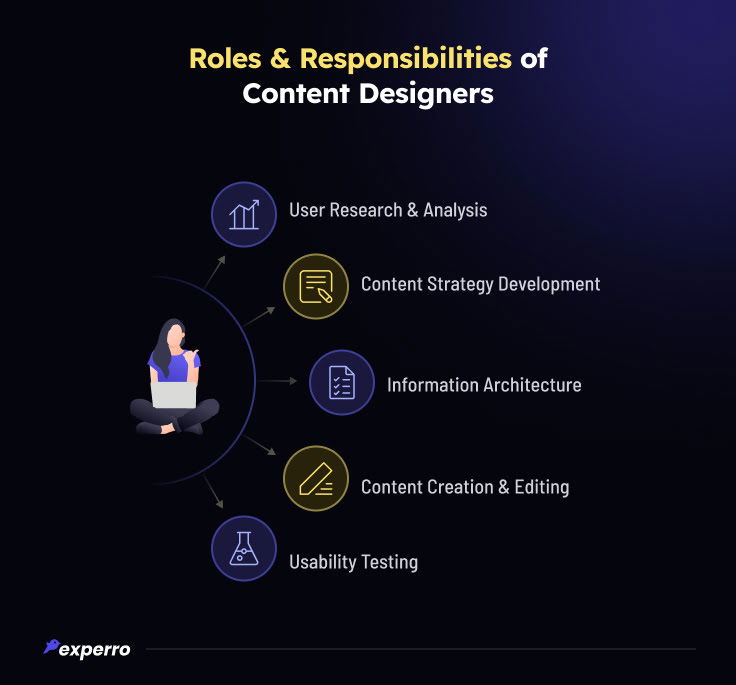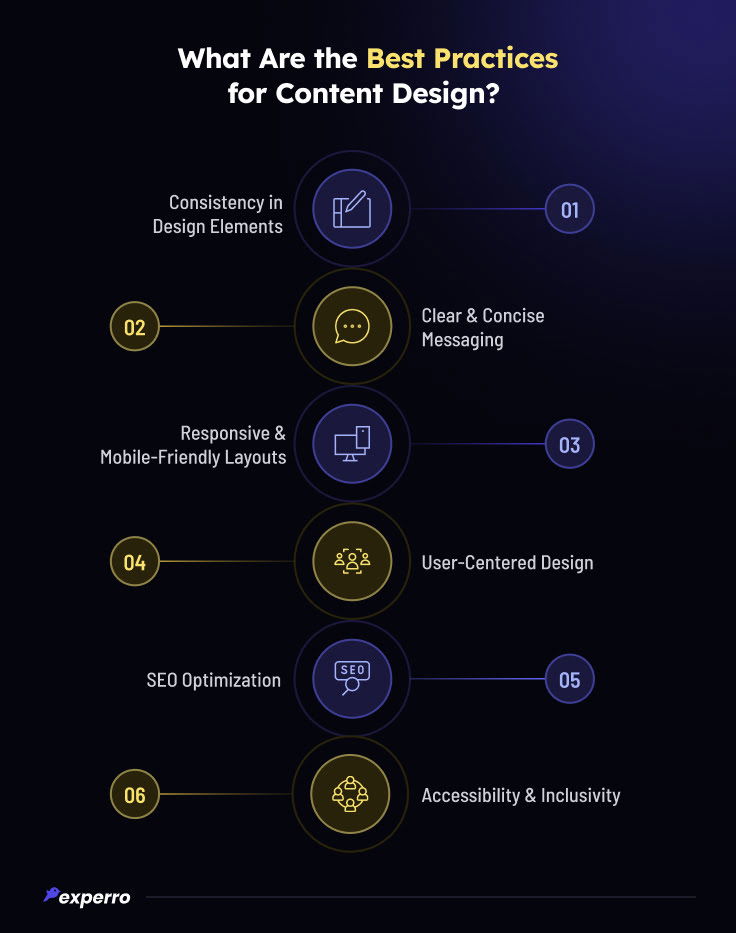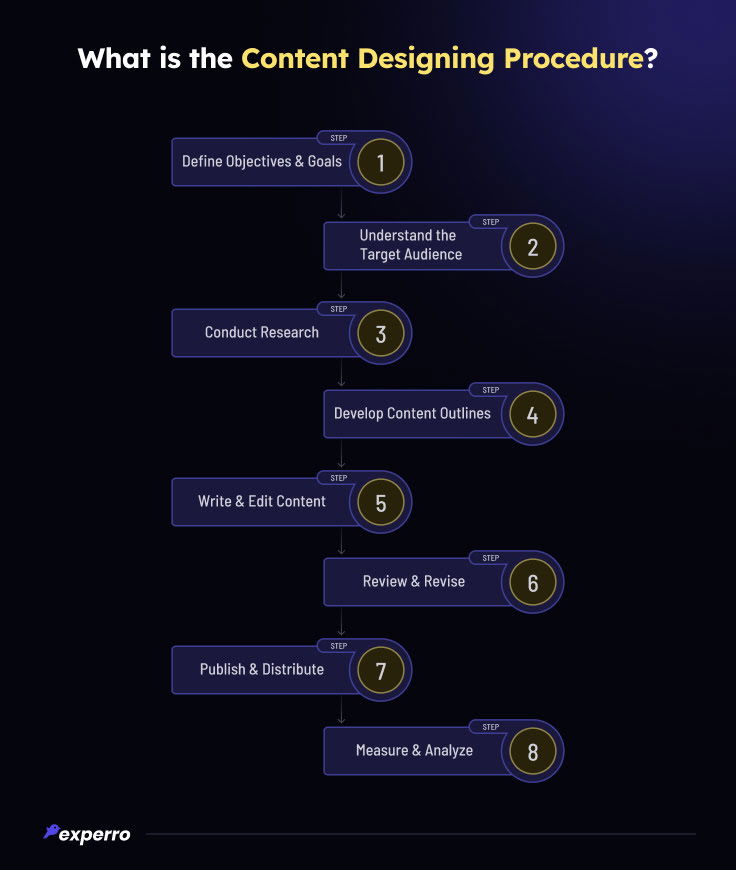What is Content Design & Why Is It Important?

What’s Inside
- What Is Content Design?
- What Is the Purpose of Content Design?
- What Does a Content Designer Do?
- Content Design Vs. UX Content Design
- What Are the Best Practices for Content Design?
- Choose Experro’s headless CMS for unparalleled flexibility and exceptional content design
- What Is the Procedure of Content Designing?
- Experro's Website Builder Is the Ultimate Choice for Content Design – How?
- Unlock the power of content design with Experro's cutting-edge website builder
- Conclusion
Key takeaways
- Content design combines creativity and strategy to craft engaging and effective digital experiences for users.
- Prioritizing a content-first design approach ensures the message stands out and enhances usability.
- Content design principles and best practices lead to higher user engagement and satisfaction.
- Experro's Website Builder supports a content-first design approach, offering seamless content management and exceptional user experiences.
Ever wondered what makes online content truly attractive and engaging? The secret lies in content design.
This essential practice combines creativity and strategy to craft digital experiences that work effectively.
Content designers ensure that every element, from text to visuals, aligns with content design principles for better usability and appeal.
By prioritizing a content-first design approach, they make sure the message stands out in every content page design.
In this blog, we’ll explore the intricacies of creative content design, from the content design process to the role of a UX content designer, and reveal how a well-structured content design system can transform your digital presence.
What Is Content Design?

Content design definition – It is the practice of planning, creating, and managing content with a focus on user experience.
It ensures information is clear, concise, and accessible, enhancing user interaction. A well-structured content page design demonstrates a thoughtful content-first approach, ensuring that the information is organized and presented clearly.
Content designers use content design principles to create an intuitive and engaging interface.
Web design impacts 94% of first impressions. An effective web design prioritizes user needs and makes content easy to navigate.
Inclusive content design ensures accessibility for all users, while creative content design showcases the potential of a strong content design portfolio.
Employing content design best practices leads to better engagement and user satisfaction. This is essential for any content design agency or UX content designer.
What Is the Purpose of Content Design?
Content design is crucial for creating effective and engaging digital experiences. It ensures that information is organized and displayed, so users can easily find what they need.
The purpose of content design is to create engaging digital experiences. This involves using creative elements to capture and retain user attention.
It is also essential for building brand credibility and trust. By delivering clear and concise information, users can easily understand and interact with the content.
What Does a Content Designer Do?
Content designers play a crucial role in crafting engaging digital experiences.
Their work goes beyond just writing; it involves research, strategy, and design to ensure useful and appealing content.

Here are the roles and responsibilities of content designers:
1. User Research and Analysis
Content designers start with understanding the audience. They conduct user research to gather insights about user needs and behaviors.
They analyze data to identify patterns and preferences, ensuring the content meets user expectations. This step is crucial in the content design process as it helps you make every decision.
2. Content Strategy Development
Once the research is complete, content designers develop a product content strategy. This involves planning what content to create and how to present it. They outline the content design principles that guide the project.
A good strategy includes a content-first design approach, ensuring the message is clear before adding design elements. The strategy also defines the tone, style, and format of the content.
3. Information Architecture
Content designers organize content in a way that makes sense to users. This is where information architecture comes in.
They create a structure for the content page design that facilitates navigation. Proper content modeling and information architecture ensure a seamless user experience.
4. Content Creation and Editing
With the strategy and structure in place, content designers create and edit the actual content. They write clear and engaging copies that follow content design best practices.
They also collaborate with designers to integrate visuals that enhance the text. The goal is to create a cohesive web content design that communicates the intended message effectively.
5. Usability Testing
Experro is one of the best platforms for usability testing. Finally, content designers can test the changes by editing and previewing the content. Usability testing helps identify any issues that need to be fixed.
They gather feedback to refine the design and ensure it works well for the users. This step ensures that the digital content design is effective and user-friendly.
Content Design Vs. UX Content Design
Content and UX content design aim to create effective and engaging content, but they focus on different aspects.
While content design emphasizes content's overall creation and structure, UX content design specifically focuses on enhancing the user experience through content.
Aspect | Content Design | UX Content Design |
| Focus | Creating and organizing content for clarity and impact. | Enhancing the user experience through strategic content placement and interaction. |
| Objective | Ensures content is well-structured and communicates the intended message clearly. | Ensures content supports and enhances the overall user experience and usability of the product. |
| Process | Involves content strategy, creation, and organization using content design principles. | Involves user research, testing, and implementation to optimize content for user interaction and satisfaction. |
| Components | Includes text, images, and other media, focusing on how these elements work together in the content designing system. | Focuses on instructional text, table of contents design, button labels, and other content elements that guide and assist users throughout their journey. |
| Tools and Techniques | Uses content management systems (CMS) and other tools to manage and publish content. | Utilizes user testing tools, wireframes, and prototypes to evaluate and improve content usability and effectiveness. |
| Outcome | Creates a cohesive content design portfolio that aligns with brand messaging and goals. | Creates a seamless user experience by ensuring content is intuitive and aids in user navigation and task completion. |
| Examples | Examples include blog posts, articles, and web content design that align with the brand's overall content strategy. | Examples include instructions and navigation menus designed to enhance usability and user satisfaction. |
What Are the Best Practices for Content Design?
Creating engaging and effective content involves following key principles.
Here are some best practices for designing content to ensure your digital content stands out and resonates with your audience.

1. Consistency in Design Elements
Consistency in the design of your content is crucial for a cohesive user experience. Using the same fonts, colors, and styles across all pages helps build a recognizable brand identity.
This includes consistent content page design, ensuring that users can easily navigate and understand the content.
Adhering to a content design system ensures that all elements work together harmoniously.
Consistency also applies to the tone and style of writing, ensuring your message is clear and professional throughout your website content design.
2. Clear and Concise Messaging
Clear and concise messaging is essential in content designing. Users prefer content that is easy to read and understand.
This means avoiding jargon and getting straight to the point. UX content designers focus on creating informative and engaging content without overwhelming the reader.
By prioritizing a content-first design, you can ensure that the core message is highlighted and not lost in unnecessary details.
This approach is especially important in digital content design, where attention spans are short.
3. Responsive and Mobile-Friendly Layouts
In today's digital world, responsive and mobile-friendly layouts are non-negotiable. A content portfolio should showcase examples of designs that look great on all devices.
Ensuring your web content design is accessible on smartphones and tablets enhances user experience and retention.
Content designers must consider how elements resize and rearrange on different screen sizes, following content design principles to maintain functionality and aesthetics.
This is crucial for content management system design, where flexibility is key. The modern headless CMS architecture allows for more flexibility than legacy systems.
4. User-Centered Design
User-centered design places the user at the heart of the content design process. Understanding user needs and behaviors helps create relevant and engaging content.
This approach involves user research and testing, ensuring the content page design meets user expectations.
You can create a more intuitive and satisfying experience by focusing on UX content designing.
Incorporating feedback and continuously improving the content based on user interactions is vital for success.
5. SEO Optimization
SEO optimization is a key component of content marketing design. It involves using relevant keywords and phrases to ensure your content ranks well in search engines.
Content designers should understand how to integrate these keywords naturally into the content.
This includes optimizing headings, meta descriptions, and body text. A well-optimized design of your content improves visibility and attracts more targeted traffic to your site.
Following content design best practices in eCommerce SEO can significantly boost your digital presence.
6. Accessibility and Inclusivity
Inclusive content design ensures that your content is accessible to all users.
This means following accessibility standards and guidelines, such as providing alt text for images and ensuring proper color contrast.
An inclusive approach to web design content also involves considering diverse user needs and preferences.
Enhancing web design with interactive elements can boost user retention by 60%.
What Is the Procedure of Content Designing?
Creating engaging and effective content involves a systematic approach known as the content design process.
This process ensures that each piece of content is well-structured, user-friendly, and meets specific goals.

Here's a breakdown of the key steps in content designing:
1. Define Objectives and Goals
The first step in designing the content is to define your objectives and goals clearly. Knowing what you want to achieve helps guide the entire process.
Are you aiming to increase engagement, drive sales, or educate your audience?
Content design principles will shape your goals. For example, a content marketing design goal might focus on impressive elements, while an educational goal may prioritize clarity and detail.
2. Understand the Target Audience
Understanding your target audience is crucial. Who are they? What do they need? What are their pain points?
This step ensures your design resonates with the right people. It involves creating audience personas and conducting surveys.
By doing this, you can tailor your content page design to address their specific interests and preferences, ensuring higher engagement and satisfaction.
3. Conduct Research
Research is a vital part of the content design process. It involves gathering information, analyzing competitors, and identifying best practices for content design.
This step helps you create content that is relevant and stands out.
Research can include keyword analysis to ensure your content ranks well in search engines and is easily discoverable.
4. Develop Content Outlines
Developing content outlines helps structure your ideas clearly. An outline serves as a strategy for your content, ensuring all necessary points are covered.
This step is essential for web content design as it helps organize information logically.
It also helps create a smooth flow, making the content easier to follow and more engaging for the audience.
5. Write and Edit Content
Your ideas come from writing and editing content. Focus on creating clear, concise, and engaging text.
Use a content-first design approach, ensuring that the message is prioritized. Editing is crucial to refine the content, correct errors, and enhance readability.
This step ensures that your final content draft is written and edited.
6. Review and Revise
Reviewing and revising your content is an important quality control step.
It includes checking for consistency, accuracy, and alignment with your goals. This step may involve feedback from colleagues or stakeholders.
Revising ensures the content meets the set content design principles and is ready to publish.
7. Publish and Distribute
Publishing and distributing your content are the next step.
Choose the right platforms to reach your target audience effectively. This could be your website, social media, or other digital channels.
Effective distribution ensures that your targeted audience sees your content at the right time.
8. Measure and Analyze
Measuring and analyzing the performance of your content is the final step.
Use eCommerce analytics tools to track metrics such as engagement, conversion rates, and user feedback.
This step helps you understand what works and what doesn’t, allowing you to refine your content design strategies for content lifecycle management.
Experro's Website Builder Is the Ultimate Choice for Content Design – How?
Experro's website builder is the ultimate choice to get the best content design for your website. It combines creativity and strategy to create digital experiences that are both engaging and effective.
The platform supports UX content design and offers a comprehensive content management system design. Its website builder ensures every aspect of your website content design is smooth and intuitive.
Additionally, Experro’s headless CMS offers unparalleled flexibility. It allows content designers to manage and deliver content across multiple channels seamlessly.
This headless CMS empowers content designers to focus on creative content design without being restricted by backend limitations.
Experro's headless CMS empowers content designers to focus on creative content design without being restricted by backend limitations.
This approach eliminates challenges such as rigid content structures, limited customization options, and complex integration processes.
Conclusion
In conclusion, content design is the pillar of creating engaging and effective digital experiences.
It combines creativity and strategy, ensuring every element aligns with content design principles for better usability and appeal.
Whether you're building a content page design, developing a content design portfolio, or focusing on inclusive content design, the ultimate aim is to communicate your message clearly and effectively.
When it comes to crafting intuitive UX content design or implementing a robust content design system, the primary focus is on ensuring an exceptional user experience and accessibility for all users.
It's important to note that a well-thought-out content strategy not only enhances usability but also significantly boosts your brand’s visibility and overall success in the marketplace.
Stay tuned with us for further updates or schedule a call with our team for one-on-one discussion!
FAQs


Pallavi Dadhich
31 May 2024Pallavi is an ambitious author known for her expertise in crafting compelling content across various domains. Beyond her professional pursuits, Pallavi is deeply passionate about continuous learning, often immersing herself in the latest industry trends. When not weaving words, she dedicates her time to mastering graphic design.